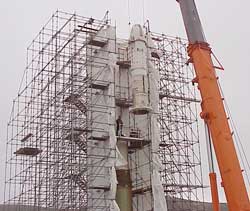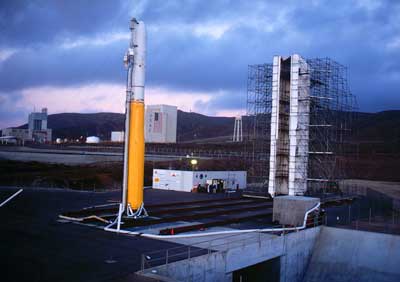
Overview of OSPSLV Minotaur rocket
U.S. AIR FORCE FACT SHEET
Posted: July 18, 2000
| |

The OSPSLV rocket during tests at Vandenberg Air Force Base in California. Photo: ORBITAL
|
The Orbital Suborbital Program Space Launch Vehicle is a combination of the Minuteman 2 ICBM system and the proven Pegasus launch vehicle. The first and second stages of the vehicle are the M-55A1 and SR-19 Minuteman 2 rocket motors respectively. The third and fourth stages are the Orion 50 XL and Orion 38 Pegasus rocket motors respectively. The basic configuration of the vehicle uses the Pegasus fairing to protect the payload.
Mission
The primary program goal is to provide low cost, reliable space launch capability in support of U.S. government small-satellite launch requirements. The program was structured to incorporate most of the development risk in the first mission followed by routine launch services operations.
Vehicle description
The OSP Space Launch Vehicle has the following characteristics:
Stage 1 (Minuteman 2 M-55A1)
Size: 66 inches in diameter and 24.6 feet long
Weight: 51,514 pounds
Thrust: About 200,435 pounds (force)
Stage 2 (Minuteman 2 SR-19)
Size: 52 inches in diameter and 13.5 feet long
Weight: 13,740 pounds
Thrust: About 60,000 pounds (force)
Stage 3 (Pegasus XL Orion 50 XL)
Size: 50 inches in diameter and 12.1 feet long
Weight: 918 pounds
Thrust: About 44,171 pounds (force)
Stage 4 (Pegasus XL Orion 38)
Size: 38 inches in diameter and 4.4 feet long
Weight: 278 pounds
Thrust: About 8,062 pounds (force)

The upper two stages and payload of the OSPSLV rocket are stacked at Vandenberg Air Force Base, Calif. Photo: Spaceport Systems International
| |
Vehicle performance
The OSP Space Launch Vehicle is considered a small launch vehicle. It can lift 750 pounds to a 400-nautical mile, sun-synchronous orbit. This is roughly 1.5 times the Pegasus XL capability.
The OSP Space Launch Vehicle can operate with two fairings allowing for the launch of oversized payloads. The standard configuration uses a slightly modified Pegasus fairing. It has a dynamic payload volume of about 46 inches in diameter by 88 inches long. The larger fairing has a dynamic payload volume of about 61 inches in diameter and is about 133 inches long.
Using the multi-payload adapter developed through a contract with One Stop Satellite Solutions (OSSS) of Ogden Utah, the OSP Space Launch Vehicle is capable of launching one large primary payload and up to four secondary payloads.
Operational details
The OSP Space Launch Vehicle is a ground launched system. It uses a launch scheme very similar to the existing Taurus launch vehicle.
This is composed of:
- Sacrificial umbilical tower
- Movable gantry system (composed of commercially procured scaffolding)
- Launch Support Van (LSV) that contains the launch vehicle support equipment and houses the launch team during operations
- Launch Equipment Vault (LEV) that houses batteries and other support equipment on the launch pad.
The M-55A1 first stage booster is required to be compliant with international arms control treaties. The treaty compliance requirements include the requirement to capture all vehicle telemetry and certain limitations on launch locations for the vehicle.
Payloads
The payload for the first mission was composite payload of two larger DoD payloads and three small micro satellite payloads. The prime payloads were the U.S. Air Force Academy's FalconSat satellite and the Air Force JAWSAT satellite. The JAWSAT vehicle also serves as a multi-payload adapter carrying three micro satellites. The micro satellites included the Optical Calibration Spheres, Stanford University's Opal satellite, and Arizona State University's satellite (ASUSAT). Additional experiments supported by the multi-payload adapter were the attitude control platform developed by One Stop Satellite Solutions and Weber State University, and NASA's plasma experiment satellite test. The demonstration mission launch occurred in January 2000. The second OSP Space Launch Vehicle mission is scheduled to launch the Air Force Research Laboratory's MightySat 2.1 payload in the summer of 2000.

A view of the OSPSLV rocket at its Vandenberg Air Force Base launch site. Space Launch Complex-6, once built to launch the space shuttle, is seen in the background to the north. Photo: ORBITAL
|
Launch sites
The vehicle is currently capable of launching from a government pad at Vandenberg Air Force Base, Calif., as well as commercial spaceports at Wallops Island, Va., Cape Canaveral, Fla., Vandenberg AFB, Calif., and Kodiak Island, Alaska. In addition, to ensure no adverse impacts to the U.S. commercial space launch capability, all payload customers must be U.S. government agencies or be sponsored by such agencies. The Secretary of Defense holds approval power for each launch mission.
Contract
The Orbital Suborbital Program Space Launch Vehicle is a new contract the Air Force awarded to Orbital Sciences Corporation in September 1997 to use surplus Minuteman 2 components for sub-orbital and orbital spacelift in support of U.S. Government requirements.

|
 |
 |
 |
Flight data file
Vehicle: OSPSLV Minotaur
Payload: Mightysat 2.1
Launch date: July 19, 2000
Launch window: 2009-2135 GMT (4:09-5:35 p.m. EDT
Launch site: CLF, Vandenberg Air Force Base, Calif.

Pre-launch briefing
Launch timeline - Chart with description of events to occur during launch.

Mightysat 2.1 - A look at the satellite to be carried aloft by Minotaur.






|

